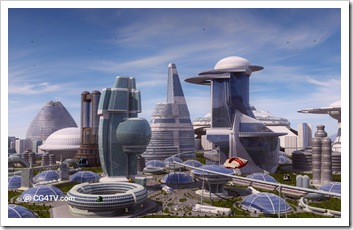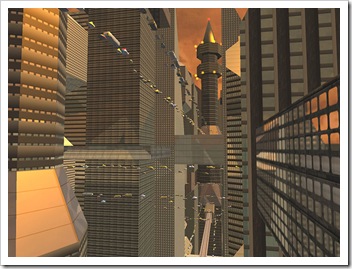Civil Engineering Analogy to Enterprise Architecture: Flawed
It is typical to see comparisons of Civil Engineering to Enterprise Architecture. A number of papers from Gartner have made the comparison, as have many articles and conference discussions. I have made the comparison myself.
It is a somewhat apt analogy. After all, both EA and Civil Engineering are responsible for setting standards (codes) that constrain the efforts of other architects.
But this is a limited and flawed analogy as well. Here is why.
Civil engineers envision this:
(Futuristic cityscape from CG4TV)
Enterprise Architects envision these:
(Futuristic cityscape from 7 art screen savers)
Notice a difference? In the first picture, the buildings are pretty, but they are silos. They are developed independently and do not interact with one another. The "shared infrastructure" between these buildings is buried underground... (sewers, electric, phone, etc). That paradigm has not changed in 100 years! The only interaction is at ground level, where the front doors are. The only "suspended" part of the image is a transportation system, but there is no evidence, in the image, that the suspended transportation system interacts with the buildings. It appears only to avoid running into them.
The second image shows not only transport systems between buildings, but suspended sections of buildings. Livable, workable, usable space between the buildings. The way in and out of each building occurs at multiple places, and those connections are more than just for transportation. In fact, how would you define a building in this city? This is more akin to the problems faced by Enterprise Architecture.
An even better image is one that I couldn't find. It would have been to show the city in LAYERS, with buildings that support a PLATFORM upon which other buildings are built, or upon which those same buildings are extended, with each layer serving unique functions. Perhaps the lower layer would include freight transport, the middle layer would perhaps include commercial and office spaces, while the top layer (closest to the sun and fresh air) would include living spaces and solar/wind power generation.
The civil engineering standards needed to produce a layered city are radically different from those needed to build a traditional city. You'd need to allow for, or even require, the creation of foundations to support structures that exceed the needs of the bottom layer. (e.g. a 10 storey building with foundations sufficient for a 60 storey building). There would have to be a mechanism to insure that costs are not shifted in an unfair manner, and that builders could replace a lower-layer building without affecting the structures above it.
The point is that civil engineering, in practice, has not made the leap to layered cities. (apparently, futuristic art has not made that leap either!) Enterprise Architecture has.
This is no criticism of civil engineering! To be fair, it is simpler to envision layers in the cyber world of an Enterprise Architect, where distance is an abstract notion, you don't have to worry about the deterioration of different materials, and both water and gravity are absent.
The analogy between EA standards to building codes is flawed because the systemic constraints that these two professions must create, and the envisioned results they are trying to produce, are radically different from one another. Comparisons between the professions are interesting, and somewhat instructive, but insufficient to advance the art of either one.

